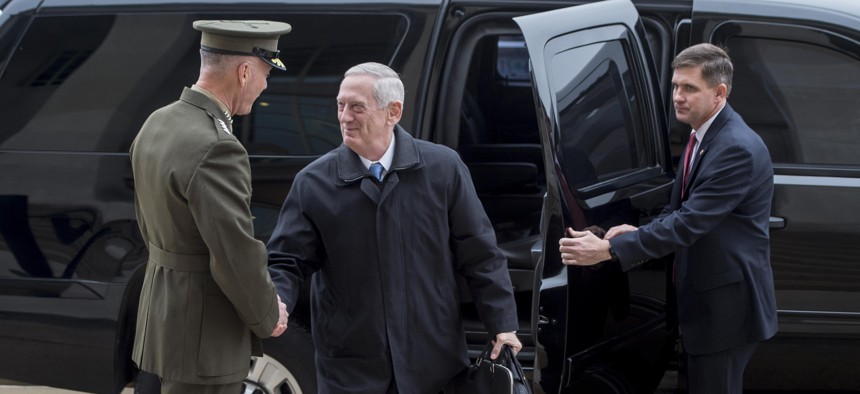
Defense Secretary Jim Mattis exchanges greetings with Marine Corps Gen. Joe Dunford, chairman of the Joint Chiefs of Staff, upon arriving at the Pentagon for his first full day as secretary, Jan. 21, 2017. Photo by Tech. Sgt. Brigitte N. Brantley
Mattis Takes on the Pentagon Bureaucracy
The defense secretary wants to reform the sprawling department’s business functions and reorganize key executive offices.
In a pair of memos to his deputy last Friday, Defense Secretary James Mattis signaled his readiness for battle against an especially entrenched foe—the department’s sprawling bureaucracy.
Both memos support requirements in the 2017 National Defense Authorization Act and aim to address concerns on Capitol Hill about Pentagon efficiency. In one memo, Mattis asked Deputy Defense Secretary Robert Work to lead a broad review of the department’s business operations with an eye to centralizing some functions now handled separately by the military services. “We have sometimes allowed our focus on service uniqueness to extend into business operations, leading to duplication of effort and costs we can no longer afford,” Mattis wrote.
Work certainly has a decent blueprint for his starting point (something Mattis pointed out in his directive): the Defense Business Board’s 2015 study “Transforming DoD’s Core Business Processes for Revolutionary Change,” which Work supported.
It appears that virtually everything is now on the table. As Mattis wrote:
“I direct you to further this work by exploring efficiencies across the following core business functions: human resource management; financial management (to include improvements in cost accounting); real property management; acquisition and contract management; logistics and supply chain management; health care management; base services (including retail operations, base lodging, and Morale, Welfare and Recreation (MWR) services; and cyber and information technology management.”
In a separate memo, Mattis directed Work to do three things:
- Develop a plan to replace the existing position of undersecretary of Defense for acquisition, technology and logistics with two new positions: undersecretary of Defense for research and engineering and undersecretary of Defense for acquisition and support.
- Consider options for improving the chief management officer function, including replacing the CMO post with an undersecretary of Defense for management, something that would require a change in law.
- Develop a plan to improve the organization and processes that support information management and cyber operations.
Work will be busy—Mattis wants an interim report on those things by Feb. 27.
NEXT STORY: A Border Wall by 2020? Doubt It
